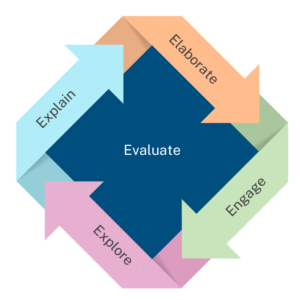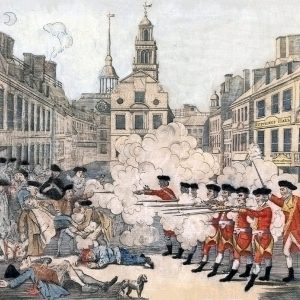Improving Students’ Critical Thinking with the 5E Model
One of the best instructional strategies for developing students’ critical thinking skills is the 5E model. This active learning approach teaches students how to dig deeper into any given topic using these five phases: Engage, Explore, Explain, Elaborate, and Evaluate.
Researchers created the 5E model in 1987 as part of a Biological Sciences Curriculum Study to improve science curriculum, according to Colette Bennett’s ThoughtCo article published April 16, 2019. After examining two groups of students, they found the group that used the inquiry-based lesson plan was four months ahead of the other group.
That’s because the 5E model teaches students to think critically, according to Charlie Perryman, professional development director at Studies Weekly. It allows them to take charge of the learning process by observing, asking questions, analyzing data, and making inferences.
“These are the kinds of skills we want our students to be able to practice when they are presented with a world of information,” Perryman said in a recent webinar.
Our world changes at such a fast rate that educators must teach more deeply than ever before, Perryman explained. Yet, how can teachers begin to predict what challenges students will face tomorrow, let alone when they’re adults? That’s why critical thinking is an essential skill for the next generation to have.
 Fortunately, designing instruction to engage high-level critical thought doesn’t have to be hard, Perryman assures.
Fortunately, designing instruction to engage high-level critical thought doesn’t have to be hard, Perryman assures.
“With the use of the 5E model, graphic organizers, and similar instructional strategies, we can take our students to a whole other level that allows them to own their learning while making connections with the content that we want to teach them,” he said.
In a recent webinar, Perryman took everyone through a 5E model exercise to show how easily educators can apply this inquiry-based strategy to their curriculum.
Phase 1: Engage
To assess students’ prior knowledge, the teacher engages students in an activity that helps them connect a concept to past and present experiences. The instructor may also ask an open-ended question to pique students’ interest and identify information gaps.
Perryman asked webinar participants, “Is social media good for democracy?” He invited them to share their answers in the chat, which showed him what they knew about fake news, politics, social campaigns like #MeToo, and the general use of social media.
Educators can use this format — “Is ___ good for ___?” — to teach any concept in a social studies, science, or life skills curriculum. . Here are some examples:
- “Is diversity good for society?”
- “Is carbon dioxide good for the environment?”
- “Is playing video games good for social well-being?”
To make it easier for teachers to determine students’ prior knowledge, have them use graphic organizers like this Defining Chart. They can also use this Know, Want to Know, Learned graphic organizer for multiple phases of the 5E model.
Phase 2: Explore
Students begin to explore the concept through hands-on activities. They make observations, discuss them with their classmates, and form hypotheses. To help them dig deeper, the teacher can ask students to come up with supporting questions to see the concept from different perspectives.
To show how this works, Perryman asked webinar attendees, “What is the point of propaganda?” to get them to look at social media’s impact on democracy in a new way.

Paul Revere’s engraving of the Boston Massacre
He presented this illustration of the Boston Massacre and asked participants to share what they saw, thought, and wondered. This led to a discussion about the author — Paul Revere — who was a member of the Sons of Liberty, a group that held anti-British views.
“It’s not hard to see that the author’s background was central to how the illustration was made,” Perryman said, pointing out how the propaganda made the British look bad.
He then asked everyone to compare Revere’s illustration with the propaganda they see on social media. Through this activity, participants considered how news spreads rapidly online, and social media bombards users with information overload.
Like Perryman demonstrated, teachers can break the inquiry process down into smaller pieces to make it engaging and less overwhelming for students.
Encourage your teachers to mimic these inquiry-based activities using the See, Think, Wonder and Compare & Contrast graphic organizers.
Phase 3: Explain
In this stage, the teacher takes the lead by asking students what they’ve learned so far, then presents them with new information to deepen their understanding.
Perryman shared research from Students’ Civic Online Reasoning, a Stanford History Education Group article published November 2019, that tested whether students could tell the difference between real and fake sources. Most students believed the fake sources were valid. Two-thirds of the study participants couldn’t even tell the difference between news stories and ads.
Perryman also mentioned Barbara R. Jasny’s Science magazine article, published in March 2018, about a study that proved robots push fake news and real news at the same speed.
“That means we’re the reason false news spreads faster than true information,” Perryman said.
To show the positive side of social media, Perryman referred to Lee Rainie’s Pew Research Center article from November 2020. According to Rainie, 84% of 397,000 expert respondents claim there will be significant social and civil innovations between now and 2030 due to social media. These developments include cyber insurance, new privacy laws, and regulations to protect social media users from cybercrimes.
“If you think about the Industrial Revolution, it presented incredible problems for our society,” Perryman said. “It was because we experienced those problems that we designed solutions like labor laws and unions to protect workers. It makes me think that maybe social media will lead to positive outcomes.”
For this phase of the 5E model, help your teachers present students with reliable information by accessing primary sources, interviews, and other bonus content available on Studies Weekly Online.
Phase 4: Elaborate
To solidify what students have learned, the teacher has the class do an activity where they connect the concept with other examples.
According to the San Diego County Office of Education, “Some students may still have misconceptions, or they may only understand a concept in terms of the exploratory experience. Elaborate activities provide time for students to apply their understanding of concepts and skills.”
After presenting the different studies, Perryman asked participants to name the pros and cons of social media and to consider the consequences of fake news spreading faster than truth. This gave the participants time to process what they just learned and think of other ways social media impacts society.
Make sure your teachers use graphic organizers like this Cause, Situation, and Effects chart so students see how new information connects with the original concept. Teachers can also engage students in a healthy debate by having them fill out this Pros and Cons chart then make an argument for each side.
Phase 5: Evaluate
The teacher concludes their 5E model instruction by going back to the concept they introduced in the Engage Phase. They assess what their students learned and clear up any misconceptions.
In the webinar, Perryman asked participants again whether they thought social media was good for democracy or not, based on the new knowledge they had. He could see how some people’s answers changed and how they backed their claims with the research they just learned.
Your teachers can have their class do an activity or group project that measures their understanding of the core concepts they’ve covered during the 5E model instruction.
“The point is to give students the opportunity to explore issues of inquiry like this and be able to make sense of that information in a way that allows them to then retrieve that information and transfer it to new and more challenging tasks,” Perryman said.
Shaping Students’ Futures with the 5E Model
Your teachers can increase students’ critical thinking while teaching core concepts by following the instructional strategy Perryman demonstrated.
“Replace the concept of social media with anything you want your students to study, and the strategy will still apply,” Perryman said. “Your students will learn how to self-reflect, observe, make inferences and comparisons, analyze, synthesize, and evaluate.”
Perryman encouraged teachers and school districts to consider how Studies Weekly’s curriculum engages students in inquiry-based learning.
“We believe in this stuff to our core. We want students to have dispositions like critical thinking, communication, collaboration so they can go out into the world and be productive members of our society. It’s a challenge to prepare our students for the trials they will face, but we can do it as long as we work together.”

Watch the full Critical Thinking webinar on-demand by completing this form.
